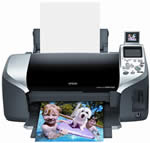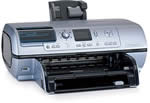Articles: "Finding the Best Photo Printer"
November 10th, 2004
by Phil Baker
I've been trying out some of the latest models of color ink-jet photo printers from Canon, Epson and HP. Each is designed to make high-quality photo prints, up to 8 1/2" x 11", as well as black and white documents, making these ideal for general use in the home or small office. All have the same list price of $199 and work with both PCs and Macs.
I looked at the Canon PIXMA iP5000, the HP 8150, and the Epson Stylus Photo R320. According to the manufacturers, each of these printers makes the best color prints of any of their models in this price range.
For my testing I printed a variety of images of people and landscapes at the best image quality setting, then printed typical Word, Excel and PowerPoint documents on plain paper. For each printer I used that printer company's own best quality photo paper for all of the photo prints.
 The Canon, a simple-looking black plastic box, has the smallest footprint of the three. It prints droplets as small as 1 picoliter, half the dot size of Canon's previous models. The Canon has two paper trays, useful to store photo paper in one and plain paper in the other.
The Canon, a simple-looking black plastic box, has the smallest footprint of the three. It prints droplets as small as 1 picoliter, half the dot size of Canon's previous models. The Canon has two paper trays, useful to store photo paper in one and plain paper in the other.
The Canon also sequentially prints on both sides of the paper with its duplex printing capability. Check the Duplex box on the print driver and the printer does the rest. This is great for multipage reports, contracts and manuscripts.
You can also use this feature for photos using Canon's new two-sided photographic paper. These prints make professional looking albums using Canon's binders, without the need to use transparent pages to mount the images back-to-back.
The HP and Epson models let you edit and print without using a computer by plugging your memory cards into slots on the printers and using an array of controls and knobs to select and adjust the images. You can crop, remove red-eye, adjust brightness and select the paper and formatting all from the printer using a tiny color LCD display to help.
Not only are these units convenient for the computer-shy, but also for those wanting to make quick prints, or use the printer while the computer is in use. But it's not a substitute for using the computer to make color corrections and fine adjustments, which most serious photographers will want to do. The HP has two paper trays while the Epson has one. But the Epson has the ability to print directly on CDs and DVDs using specially coated discs that slide into a slot on the printer.
 While all of these features are interesting, what's most important is the quality of the photos.
While all of these features are interesting, what's most important is the quality of the photos.
For plain paper printing such as Word documents, spreadsheets and PowerPoint slides, the output from all three was excellent. However, under magnification, the HP text images were just slightly sharper and blacker. The Canon printed the fastest, followed by the HP and the Epson. A Word page took 9, 16 and 24 seconds, respectively; a spreadsheet took 15, 25 and 30 seconds; and a PowerPoint slide with colored graphics took 25, 25 and 35 seconds.
For photos, the print quality of the Epson and Canon were equally superb and hard to tell apart, while the HP was excellent but not as good. The HP images had a subtle "engraved" look between the transitions of colors and the colors were slightly cooler. HP uses two cartridges, a black and a tri-color, compared to the Canon and Epson's six. With the HP you need to replace the tri-color when one of the three colors runs out, which can be more costly. Prints made with Epson's and Canon's high gloss photo papers looked most like photographic prints.
Printing time for 4" x 6" color photos was 70 seconds for HP, 90 seconds for Canon and 105 seconds for Epson. For 8 x 10 prints, Canon and HP took about two minutes and Epson took nearly three minutes.
 HP recommends using two different pairs of cartridges, one for plain paper printing and the other for photos. You need to store the unused cartridges in an airtight container to prevent them from drying out and remember to switch back and forth. Also, HP's 4" x 6" photo paper has extensions at each end of the paper which need to be trimmed after printing.
HP recommends using two different pairs of cartridges, one for plain paper printing and the other for photos. You need to store the unused cartridges in an airtight container to prevent them from drying out and remember to switch back and forth. Also, HP's 4" x 6" photo paper has extensions at each end of the paper which need to be trimmed after printing.
All three companies say they've made progress in improving their prints' resistance to fading under bright lighting, claiming 70 to 100 years' life in a bright room. (I didn't have time to test their claims!) Although rarely mentioned, moisture can also be an enemy of print stability, so I gently wiped each image with a moistened tissue after the images had fully dried. The results were surprising and unexpected.
While the Epson and Canon prints were not affected, the ink on the HP prints simply wiped off, destroying the print. That's a major deficiency of HP's printing process.
Since I place primary importance on photo quality, my recommendations are the Epson and Canon. Choose the Epson if you want the capability to print directly from the printer or on CDs, and the Canon if the duplex printing, two paper trays and higher speed are more important. Both make some of the best photos of any printer I've used, significantly better than their predecessors just a few years ago, and at a reasonable price.
Related Links
San Diego Transcript technology column
Check the Latest Prices for the Canon Pixma iP5000
